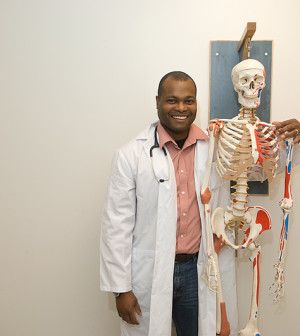- Double Mastectomy May Offer No Survival Benefit to Women With Breast Cancer
- Toxic Lead Found in Cinnamon Product, FDA Says
- Certain Abbott Blood Sugar Monitors May Give Incorrect Readings
- Athletes Can Expect High Ozone, Pollen Counts for Paris Olympics
- Fake Oxycontin Pills Widespread and Potentially Deadly: Report
- Shingles Vaccine Could Lower Dementia Risk
- Your Odds for Accidental Gun Death Rise Greatly in Certain States
- Kids From Poorer Families Less Likely to Survive Cancer
- Tough Workouts Won’t Trigger Cardiac Arrest in Folks With Long QT Syndrome
- At-Home Colon Cancer Test Can Save Lives
Exercise in Youth Boosts Bone Strength Later: Study


FRIDAY, March 28 HealthDay News) — Physical exercise at a young age increases bone health, and those benefits continue with age, a new study of baseball players finds.
And people who continue to exercise as they grow older have even greater bone health benefits, said lead researcher Stuart Warden, associate dean for research at Indiana University’s School of Health and Rehabilitation Sciences.
The study “basically supports the idea that you need to exercise when you are young to optimize your bone health,” he said.
For the study, published online March 24 in PNAS Early Edition, Warden studied 103 professional baseball players, comparing bone mass, size and strength in their throwing and non-throwing arms during active play and after retirement.
In their youth, “they increased the mass and size of the bone,” he said. “As a result, the bone got stronger.”
When they stopped playing ball, the bone mass benefit disappeared, but the size benefit didn’t, the study found. “As a result, the strength remained,” Warden said, explaining that the strength of a bone is dependent on both its mass and size.
By their 80s, inactive players had lost all their bone mass benefits. But they held onto more than half of the bone size benefits and one-third of the bone strength benefits from their youthful exercise.
“Even though they hadn’t exercised in 50 years, they still had a bigger, stronger bone in their throwing arm,” Warden said.
Players who remained active held onto 28 percent of their bone mass benefits and half of the strength benefits from their youth, he said.
The findings weren’t a surprise, Warden said. The study included only men, so Warden can’t say for sure if the same would be true for women, but he suspects it would be.
The study findings make sense to Heather McKay, director of the Center for Hip Health and Mobility at the University of British Columbia, Vancouver, who was not involved in the research.
“We know that childhood and the growing years offer that window of opportunity,” she said of bone health. “What Dr. Warden has been able to do is drill down more specifically into the mechanisms that explain bone strength.”
The bone strength achieved by exercise is bone-specific, said McKay, who is also a professor of medicine. The study was able to demonstrate that by measuring the throwing arms, which were much stronger than the other arms.
The findings should inspire people of any age to keep moving, or get moving, she said. While childhood is the ideal time to exercise to build bones, she said, “in adulthood you can still retain your skeleton. In older age, it’s about maintenance.”
Without maintenance, bone health declines, she said, and boosts the risk of disabling fractures.
It’s not known whether the findings would apply to the hips and other sites prone to fractures from the bone-thinning disease osteoporosis.
More information
To learn about bone health for girls, visit the U.S. Department of Health and Human Services.
Source: HealthDay
Copyright © 2024 HealthDay. All rights reserved.










